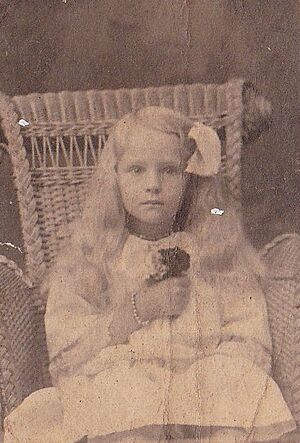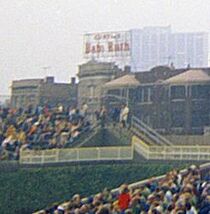Baby Ruth facts for kids
 |
|
 |
|
| Type | Confectionery |
|---|---|
| Owner | Ferrara Candy Company |
| Country | United States |
| Introduced | 1920 |
| Previous owners |
|
The Baby Ruth is a yummy American candy bar! It has peanuts, chewy caramel, and a soft, chocolatey center called nougat. All of this is covered in a tasty chocolate coating. It was first made in 1920 and is now produced by the Ferrara Candy Company.
Contents
The Story of Baby Ruth
How the Candy Bar Started
The Baby Ruth candy bar began in 1920. A company called the Curtiss Candy Company changed their "Kandy Kake" bar into the Baby Ruth. It quickly became super popular! By the late 1920s, it was the best-selling candy bar that cost five cents. The Curtiss Candy Company, based in Chicago, made this candy bar for over 60 years.
Who Owns Baby Ruth Now?
Over the years, the Baby Ruth candy bar has had a few different owners. In 1981, Nabisco bought the Curtiss Candy Company. Later, in 1990, RJR Nabisco sold the Curtiss brands to Nestlé. Then, in 2018, the Ferrero company bought Nestlé USA's candy brands, including Baby Ruth. Ferrero then moved the making of these candies to its Ferrara Candy Company.
In December 2019, Ferrara brought out a new version of the Baby Ruth bar. This new recipe uses peanuts grown in the United States that are dry-roasted. Before, the peanuts were roasted in oil. The company also removed a food preservative called TBHQ.
What's in a Name?

The name "Baby Ruth" sounds a lot like the famous baseball player Babe Ruth. However, the Curtiss Candy Company said the bar was named after Ruth Cleveland. She was the daughter of former United States President Grover Cleveland.
The company started making the "Baby Ruth" bar in 1921. This was when Babe Ruth was becoming very famous. It was also 24 years after President Cleveland had left the White House. His daughter, Ruth, had passed away 17 years before the candy bar was named.
Many people thought the company's story was a way to avoid paying the baseball player for using his name. The candy company was even located on the same street as Wrigley Field, a famous baseball stadium.
The Name Debate
There has been some debate about the true origin of the name. Author David Feldman shared the story about President Cleveland's daughter. He also mentioned that the candy bar's name looked like the lettering on a special medal from the 1893 Chicago World's Columbian Exposition. This medal showed the President, his wife, and their daughter, Baby Ruth.
However, some people, like Tom Burnam, believed the candy bar was named after the granddaughter of Mr. and Mrs. George Williamson. The Williamsons were candy makers who supposedly created the original recipe. They had also sold the "Oh Henry!" candy bar recipe to Curtiss around the same time. It's thought that naming the bar after a company executive's granddaughter might not have been as popular for marketing.
But Snopes.com says that the Williamsons did not invent the recipe. George Williamson was in charge of the Williamson Candy Company, which made the Oh Henry! bar. Instead, Otto Schnering, who started the Curtiss Candy Company, changed his first candy, "Kandy Kake," to create the Baby Ruth bar.
How Baby Ruth Was Advertised

Early Promotions
To make the candy bar famous, company founder Otto Schnering did something amazing in 1923. He hired a plane to drop thousands of Baby Ruth bars over the city of Pittsburgh. Each candy bar had its own tiny parachute! After that, Schnering did these parachute drops in many cities across more than 40 states.
In 1929, the Curtiss Candy Company also sponsored a CBS Radio show called The Baby Ruth Hour.
Connecting to Baseball
The company seemed to hint at the connection to Babe Ruth, even though they officially denied it. After Babe Ruth hit a famous home run at Chicago's Wrigley Field during the 1932 World Series, Curtiss put up a bright Baby Ruth sign. It was on the roof of a building across from the field, near where Ruth's home run ball landed. This sign stayed there for about 40 years.
In 1985, Nabisco paid $100,000 for Baby Ruth to appear in the movie The Goonies.
In 1995, a company representing Babe Ruth's family allowed his name and picture to be used in a Baby Ruth advertising campaign. This was a big change!
Baby Ruth has also been called "The official candy bar of major league baseball." In 2007, a TV ad showed a whole stadium full of people eating Baby Ruths. Because their mouths were full, they had to hum instead of singing "Take Me Out to the Ball Game" during the seventh-inning stretch.
What's Inside a Baby Ruth?
The Baby Ruth bar is made with several ingredients that give it its unique taste. The main ingredients include sugar, dry roasted peanuts, and corn syrup. It also has hydrogenated vegetable oil, nonfat milk, and cocoa. Other ingredients like salt, soy lecithin, and natural and artificial flavors are added to make it delicious.
Different Sizes
You can find Baby Ruth bars in a few different sizes. There's the regular "Full Size" bar, which is about 1.9 ounces (53.8 grams). You can also get a larger "King Size" bar, which is about 3.7 ounces (105 grams). For sharing, there's a "Share Pack" with two pieces. And for smaller treats, you can find "Fun Size" and "Miniatures" packages.
Other Baby Ruth Treats
Nestlé used to make a Baby Ruth ice cream bar. It had a milk chocolate coating, chocolate-covered peanuts, and a vanilla-and-nougat flavored ice cream center. Nestlé also made Baby Ruth Crisp bars. These were chocolate-covered wafer cookies with a caramel-flavored cream and crushed peanuts.
See also


